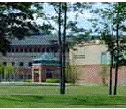






















|
|
Particle Deposition Mechanisms: Impaction Rebounds Particles striking a surface at high speed could rebound. It may be shown that for normal impact
When
For velocities less than |


|
                    
|
|
|
Dr. Goodarz Ahmadi |
Turbulence & Multiphase Fluid Flow Laboratory |
Department of Mechanical & Aeronautical Engineering
|